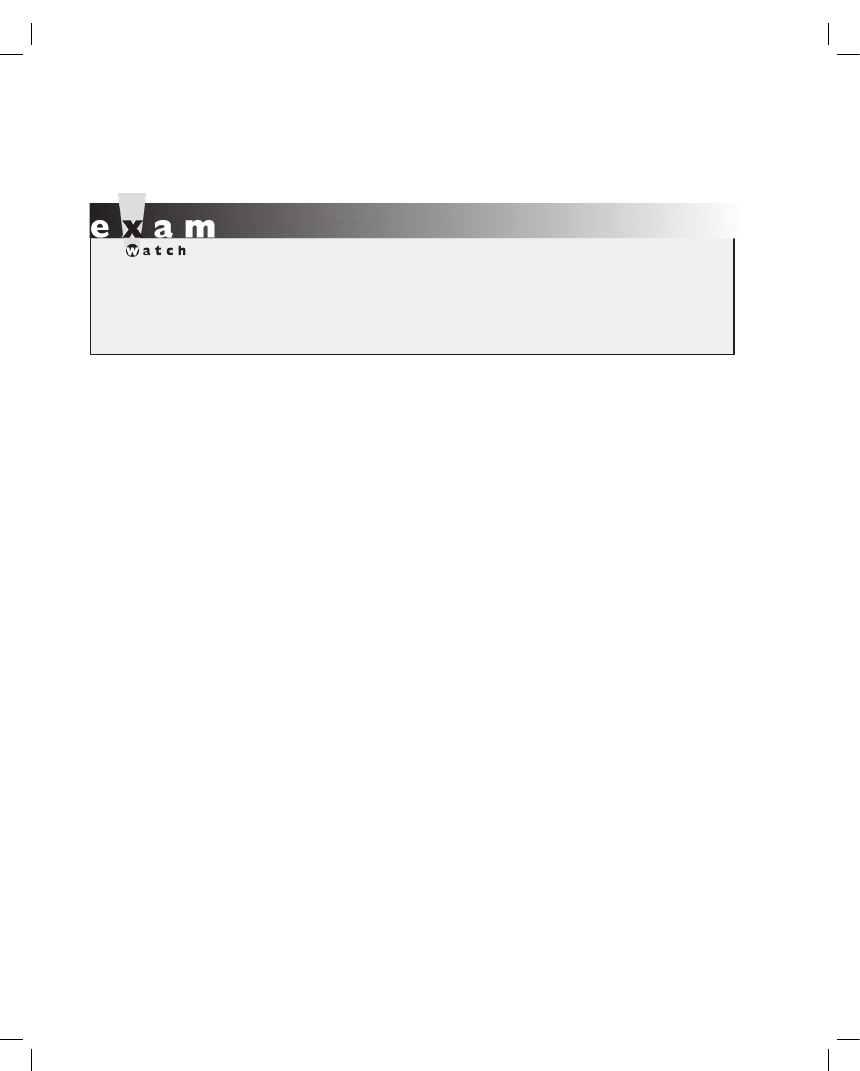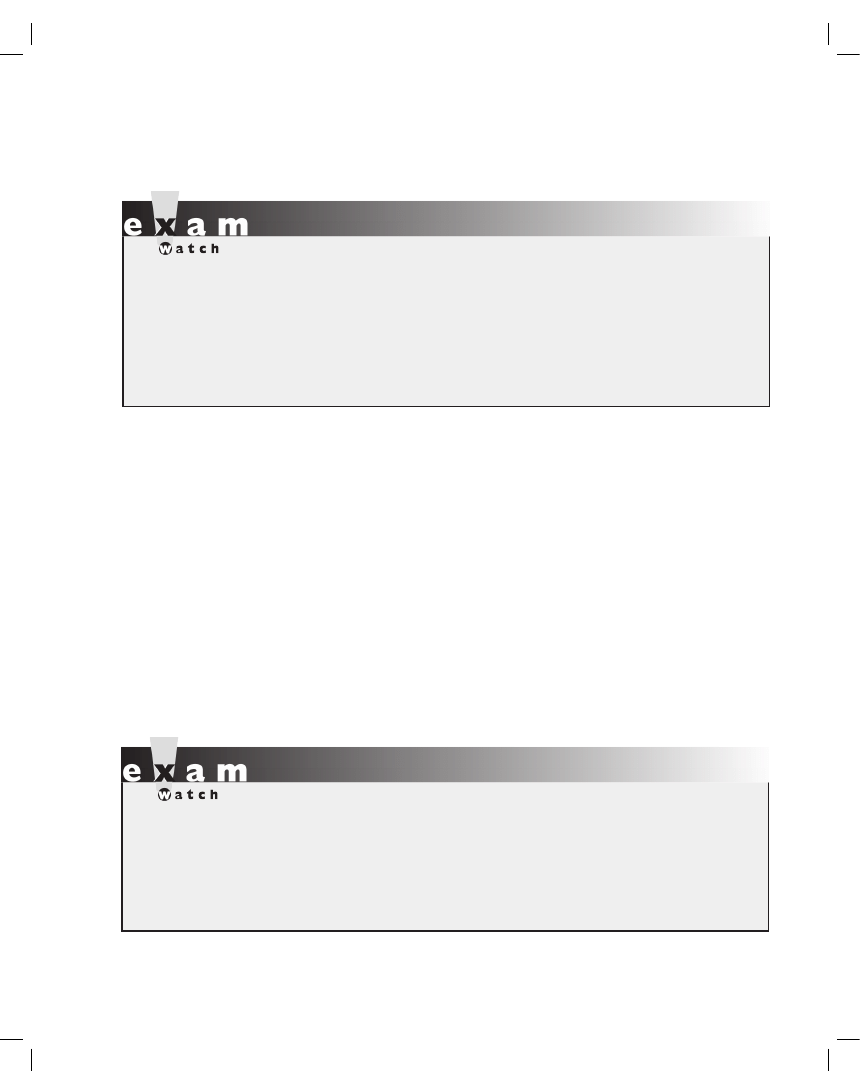
CertPrs8/Java 5 Cert. Study Guide/Sierra-Bates/225360-6/Chapter 10
Blind Folio
759
10
Development
CertifiCation objeCtives
l
UsePackagesandImports
l
DetermineRuntimeBehavior
forClassesandCommand-Lines
l
UseClassesinJARFiles
l
UseClasspathsto
CompileCode
3
Two-MinuteDrill
Q&A
SelfTest
ch10-1128f.indd 759
11/28/05 1:01:54 PM

CertPrs8/Java 5 Cert. Study Guide/Sierra-Bates/225360-6/Chapter 10
760
Chapter10: Development
Y
ouwanttokeepyourclassesorganized.Youneedtohavepowerfulwaysforyourclasses
tofindeachother.Youwanttomakesurethatwhenyou'relookingforaparticularclass
yougettheoneyouwant,andnotanotherclassthathappenstohavethesamename.In
thischapterwe'llexploresomeoftheadvancedcapabilitiesofthejavaandjavaccommands.We'll
revisittheuseofpackagesinJava,andhowtosearchforclassesthatliveinpackages.
CertifiCation objeCtives
Using the javac and java Commands (objective 7.2)
7.1 Given a code example and a scenario, write code that uses the appropriate access
modifiers, package declarations, and import statements to interact with (through access or
inheritance) the code in the example.
7.2 Given an example of a class and a command-line, determine the expected runtime
behavior.
7.5 Given the fully-qualified name of a class that is deployed inside and/or outside a JAR
file, construct the appropriate directory structure for that class. Given a code example and a
classpath, determine whether the classpath will allow the code to compile successfully.
So far in this book, we've probably talked about invoking the
javac
and
java
commands about 1000 times; now we're going to take a closer look.
Compiling with javac
The
javac
command is used to invoke Java's compiler. In Chapter 5 we talked
about the assertion mechanism and when you might use the
-source
option when
compiling a file. There are many other options you can specify when running
javac
,
options to generate debugging information or compiler warnings for example. For
the exam, you'll need to understand the
-classpath
and
-d
options, which we'll
cover in the next few pages. In addition, it's important to understand the structure of
this command. Here's the overview:
javac [options] [source files]
ch10-1128f.indd 760
11/28/05 1:01:55 PM

Compilingwithjavac(ExamObjective7.2)
761
There are additional command-line options called
@argfiles
, but you won't
need to study them for the exam. Both the
[options]
and the
[source files]
are optional parts of the command, and both allow multiple entries. The following
are both legal
javac
commands:
javac -help
javac -classpath com:. -g Foo.java Bar.java
The first invocation doesn't compile any files, but prints a summary of valid
options. The second invocation passes the compiler two options (
-classpath
,
which itself has an argument of
com:.
and
-g
), and passes the compiler two
.java
files to compile (
Foo.java
and
Bar.java
). Whenever you specify multiple options
and/or files they should be separated by spaces.
Compiling with -d
By default, the compiler puts a
.class
file in the same directory as the
.java
source
file. This is fine for very small projects, but once you're working on a project of any
size at all, you'll want to keep your
.java
files separated from your
.class
files.
(This helps with version control, testing, deployment...) The
-d
option lets you tell
the compiler in which directory to put the
.class
file(s) it generates (
d
is for
destination). Let's say you have the following directory structure:
myProject
|
|--source
| |
| |-- MyClass.java
|
|-- classes
|
|--
The following command, issued from the
myProject
directory, will compile
MyClass.java
and put the resulting
MyClass.class
file into the
classes
directory. (Note: This assumes that MyClass does not have a package statement;
we'll talk about packages in a minute.)
cd myProject
javac -d classes source/MyClass.java
CertPrs8/A+ Certification Study Guide/Pastore/222766-4/Chapter 10
ch10-1128f.indd 761
11/28/05 1:01:55 PM

CertPrs8/Java 5 Cert. Study Guide/Sierra-Bates/225360-6/Chapter 10
This command also demonstrates selecting a
.java
file from a subdirectory of the
directory from which the command was invoked. Now let's take a quick look at how
packages work in relationship to the
-d
option.
Suppose we have the following
.java
file in the following directory structure:
package com.wickedlysmart;
public class MyClass { }
myProject
|
|--source
| |
| |--com
| |
| |--wickedlysmart
| |
| |--MyClass.java
|
|--classes
| |
| |--com
| |
| |--wickedlysmart
| |
| |-- (MyClass.class goes here)
If you were in the
source
directory, you would compile
MyClass.java
and put
the resulting
MyClass.class
file into the
classes/com/wickedlysmart
directory
by invoking the following command:
javac -d ../classes com/wickedlysmart/MyClass.java
This command could be read: "To set the destination directory,
cd
back to
the
myProject
directory then
cd
into the
classes
directory, which will be your
destination. Then compile the file named
MyClass.java
. Finally, put the resulting
MyClass.class
file into the directory structure that matches its package, in this
case,
classes/com/wickedlysmart.
" Because
MyClass.java
is in a package,
the compiler knew to put the resulting
.class
file into the
classes/com/wickedlysmart
directory.
762
Chapter10: Development
ch10-1128f.indd 762
11/28/05 1:01:55 PM

CertPrs8/Java 5 Cert. Study Guide/Sierra-Bates/225360-6/Chapter 10
Somewhat amazingly, the
javac
command can sometimes help you out by
building directories it needs! Suppose we have the following:
package com.wickedlysmart;
public class MyClass { }
myProject
|
|--source
| |
| |--com
| |
| |--wickedlysmart
| |
| |--MyClass.java
|
|--classes
| |
And the following command (the same as last time):
javac -d ../classes com/wickedlysmart/MyClass.java
In this case, the compiler will build two directories called
com
and
com/wickedlysmart
in order to put the resulting
MyClass.class
file
into the correct package directory (
com/wickedlysmart/
) which it builds within
the existing
.../classes
directory.
The last thing about
-d
that you'll need to know for the exam is that if the
destination directory you specify doesn't exist, you'll get a compiler error. If, in the
previous example, the
classes
directory did NOT exist, the compiler would say
something like:
java:5: error while writing MyClass: classes/MyClass.class (No
such file or directory)
Launching applications with java
The
java
command is used to invoke the Java virtual machine. In Chapter 5 we
talked about the assertion mechanism and when you might use flags such as
-ea
or
-da
when launching an application. There are many other options you can specify
LaunchingApplicationswithjava(ExamObjective7.2)
763
ch10-1128f.indd 763
11/28/05 1:01:56 PM

CertPrs8/Java 5 Cert. Study Guide/Sierra-Bates/225360-6/Chapter 10
when running the
java
command, but for the exam, you'll need to understand
the
-classpath
(and its twin
-cp
) and
-D
options, which we'll cover in the next
few pages. In addition, it's important to understand the structure of this command.
Here's the overview:
java [options] class [args]
The
[options]
and
[args]
parts of the
java
command are optional, and they
can both have multiple values. You must specify exactly one class file to execute, and
the
java
command assumes you're talking about a
.class
file, so you don't specify
the
.class
extension on the command line. Here's an example:
java -DmyProp=myValue MyClass x 1
Sparing the details for later, this command can be read as "Create a system
property called
myProp
and set its value to
myValue
. Then launch the file named
MyClass.class
and send it two String arguments whose values are
x
and
1
."
Let's look at system properties and command-line arguments more closely.
Using system Properties
Java 5 has a class called
java.util.Properties
that can be used to access a
system's persistent information such as the current versions of the operating system,
the Java compiler, and the Java virtual machine. In addition to providing such
default information, you can also add and retrieve your own properties. Take a look
at the following:
import java.util.*;
public class TestProps {
public static void main(String[] args) {
Properties p = System.getProperties();
p.setProperty("myProp", "myValue");
p.list(System.out);
}
}
If this file is compiled and invoked as follows:
java -DcmdProp=cmdVal TestProps
You'll get something like this:
764
Chapter10: Development
ch10-1128f.indd 764
11/28/05 1:01:56 PM

CertPrs8/Java 5 Cert. Study Guide/Sierra-Bates/225360-6/Chapter 10
...
os.name=Mac OS X
myProp=myValue
...
java.specification.vendor=Sun Microsystems Inc.
user.language=en
java.version=1.5.0_02
...
cmdProp=cmdVal
...
where the . . . represent lots of other name=value pairs. (The name and value are
sometimes called the key and the property.) Two name=value properties were added
to the system's properties:
myProp=myValue
was added via the
setProperty
method, and
cmdProp=cmdVal
was added via the
-D
option at the command line.
When using the
-D
option, if your value contains white space the entire value
should be placed in quotes like this:
java -DcmdProp="cmdVal take 2" TestProps
Just in case you missed it, when you use
-D,
the name=value pair must follow
immediately, no spaces allowed.
The
getProperty()
method is used to retrieve a single property. It can be
invoked with a single argument (a String that represents the name (or key)), or it
can be invoked with two arguments, (a String that represents the name (or key),
and a default String value to be used as the property if the property does not already
exist). In both cases,
getProperty()
returns the property as a String.
Handling Command-Line arguments
Let's return to an example of launching an application and passing in arguments
from the command line. If we have the following code:
public class CmdArgs {
public static void main(String[] args) {
int x = 0;
for(String s : args)
System.out.println(x++ + " element = " + s);
}
}
LaunchingApplicationswithjava(ExamObjective7.2)
765
ch10-1128f.indd 765
11/28/05 1:01:56 PM

766
Chapter10: Development
CertPrs8/Java 5 Cert. Study Guide/Sierra-Bates/225360-6/Chapter 10
compiled and then invoked as follows
java CmdArgs x 1
the output will be
0 element = x
1 element = 1
Like all arrays,
args
index is zero based. Arguments on the command line
directly follow the class name. The first argument is assigned to
args[0]
, the second
argument is assigned to
args[1]
, and so on.
Finally, there is some flexibility in the declaration of the
main()
method that
is used to start a Java application. The order of
main()
's modifiers can be altered
a little, the String array doesn't have to be named
args
, and as of Java 5 it can be
declared using var-args syntax. The following are all legal declarations for
main()
:
static public void main(String[] args)
public static void main(String... x)
static public void main(String bang_a_gong[])
searching for other Classes
In most cases, when we use the
java
and
javac
commands, we want these
commands to search for other classes that will be necessary to complete the
operation. The most obvious case is when classes we create use classes that Sun
provides with J2SE (now sometimes called Java SE), for instance when we use classes
in
java.lang
or
java.util
. The next common case is when we want to compile a
file or run a class that uses other classes that have been created outside of what Sun
provides, for instance our own previously created classes. Remember that for any
given class, the
java
virtual machine will need to find exactly the same supporting
classes that the
javac
compiler needed to find at compilation time. In other words,
if
javac
needed access to
java.util.HashMap
then the
java
command will need
to find
java.util.HashMap
as well.
Both
java
and
javac
use the same basic search algorithm:
1. They both have the same list of places (directories) they search, to look
for classes.
ch10-1128f.indd 766
11/28/05 1:01:57 PM

CertPrs8/Java 5 Cert. Study Guide/Sierra-Bates/225360-6/Chapter 10
2
. They both search through this list of directories in the same order.
3
. As soon as they find the class they're looking for, they stop searching for that
class. In the case that their search lists contain two or more files with the
same name, the first file found will be the file that is used.
4
. The first place they look is in the directories that contain the classes that
come standard with J2SE.
5
. The second place they look is in the directories defined by classpaths.
6
. Classpaths should be thought of as "class search paths." They are lists of
directories in which classes might be found.
7
. There are two places where classpaths can be declared:
A classpath can be declared as an operating system environment variable.
The classpath declared here is used by default, whenever
java
or
javac
are
invoked.
A classpath can be declared as a command-line option for either
java
or
javac
. Classpaths declared as command-line options override the classpath declared
as an environment variable, but they persist only for the length of the invocation.
Declaring and Using Classpaths
Classpaths consist of a variable number of directory locations, separated by
delimiters. For Unix-based operating systems, forward slashes are used to
construct directory locations, and the separator is the colon (:). For example:
-classpath /com/foo/acct:/com/foo
specifies two directories in which classes can be found:
/com/foo/acct
and
/com/foo
. In both cases, these directories are absolutely tied to the root of the file
system, which is specified by the leading forward slash. It's important to remember
that when you specify a subdirectory, you're NOT specifying the directories above it.
For instance, in the preceding example the directory
/com
will NOT be searched.
SearchingforOtherClasses(ExamObjective7.5)
767
ch10-1128f.indd 767
11/28/05 1:01:57 PM

768
Chapter10: Development
CertPrs8/Java 5 Cert. Study Guide/Sierra-Bates/225360-6/Chapter 10
A very common situation occurs in which
java
or
javac
complains that it can't
find a class file, and yet you can see that the file is IN the current directory! When
searching for class files, the
java
and
javac
commands don't search the current
directory by default. You must tell them to search there. The way to tell
java
or
javac
to search in the current directory is to add a dot (.) to the classpath:
-classpath /com/foo/acct:/com/foo:.
This classpath is identical to the previous one EXCEPT that the dot (.) at the end
of the declaration instructs
java
or
javac
to also search for class files in the current
directory. (Remember, we're talking about class files—when you're telling
javac
which
.java
file to compile,
javac
looks in the current directory by default.)
It's also important to remember that classpaths are searched from left to right.
Therefore in a situation where classes with duplicate names are located in several
different directories in the following classpaths, different results will occur:
-classpath /com:/foo:.
is not the same as
-classpath .:/foo:/com
Finally, the
java
command allows you to abbreviate
-classpath
with
-cp
. The
Java documentation is inconsistent about whether the
javac
command allows the
-cp
abbreviation. On most machines it does, but there are no guarantees.
Most of the path-related questions on the exam will use Unix conventions.
If you are a Windows user, your directories will be declared using backslashes (
\
) and the
separator character you use will be a semicolon (;). But again, you will NOT need any
shell-specific knowledge for the exam.
ch10-1128f.indd 768
11/28/05 1:01:58 PM

CertPrs8/Java 5 Cert. Study Guide/Sierra-Bates/225360-6/Chapter 10
Packages and searching
When you start to put classes into packages, and then start to use classpaths to find
these classes, things can get tricky. The exam creators knew this, and they tried
to create an especially devilish set of package/classpath questions with which to
confound you. Let's start off by reviewing packages. In the following code:
package com.foo;
public class MyClass { public void hi() { } }
we're saying that
MyClass
is a member of the
com.foo
package. This means that
the fully qualified name of the class is now
com.foo.MyClass
. Once a class is in
a package, the package part of its fully qualified name is atomic—it can never be
divided. You can't split it up on the command-line, and you can't split it up in an
import
statement.
Now let's see how we can use
com.foo.MyClass
in another class:
package com.foo;
public class MyClass { public void hi() { } }
And in another file:
import com.foo.MyClass; // either import will work
import com.foo.*;
public class Another {
void go() {
MyClass m1 = new MyClass(); // alias name
com.foo.MyClass m2 = new com.foo.MyClass(); // full name
m1.hi();
m2.hi();
}
}
It's easy to get confused when you use
import
statements. The preceding code
is perfectly legal. The
import
statement is like an alias for the class's fully qualified
name. You define the fully qualified name for the class with an
import
statement (or
with a wildcard in an
import
statement of the package). Once you've defined the
fully qualified name, you can use the "alias" in your code—but the alias is referring
back to the fully qualified name.
SearchingforOtherClasses(ExamObjective7.5)
769
ch10-1128f.indd 769
11/28/05 1:01:59 PM

770
Chapter10: Development
CertPrs8/Java 5 Cert. Study Guide/Sierra-Bates/225360-6/Chapter 10
Now that we've reviewed packages, let's take a look at how they work in
conjunction with classpaths and command lines. First we'll start off with the idea
that when you're searching for a class using its fully qualified name, that fully
qualified name relates closely to a specific directory structure. For instance, relative
to your current directory, the class whose source code is
package com.foo;
public class MyClass { public void hi() { } }
would have to be located here:
com/foo/MyClass.class
In order to find a class in a package, you have to have a directory in your classpath
that has the package's leftmost entry (the package's "root") as a subdirectory.
This is an important concept, so let's look at another example:
import com.wickedlysmart.Utils;
class TestClass {
void doStuff() {
Utils u = new Utils(); // simple name
u.doX("arg1", "arg2");
com.wickedlysmart.Date d =
new com.wickedlysmart.Date(); // full name
d.getMonth("Oct");
}
}
In this case we're using two classes from the package
com.wickedlysmart
. For
the sake of discussion we imported the fully qualified name for the
Utils
class,
and we didn't for the
Date
class. The only difference is that because we listed
Utils
in an
import
statement, we didn't have to type its fully qualified name
inside the class. In both cases the package is
com.wickedlysmart
. When it's time
to compile or run
TestClass
, the classpath will have to include a directory with
the following attributes:
n
A subdirectory named
com
(we'll call this the "package root" directory)
n
A subdirectory in
com
named
wickedlysmart
n
Two files in
wickedlysmart
named
Utils.class
and
Date.class
ch10-1128f.indd 770
11/28/05 1:01:59 PM

CertPrs8/Java 5 Cert. Study Guide/Sierra-Bates/225360-6/Chapter 10
Finally, the directory that has all of these attributes has to be accessible (via a
classpath) in one of two ways:
1. The path to the directory must be absolute, in other words, from the root (the file
system root, not the package root).
or
2. The path to the directory has to be correct relative to the current directory.
relative and absolute Paths
A classpath is a collection of one or more paths. Each path in a classpath is either
an absolute path or a relative path. An absolute path in Unix begins with a forward
slash (/) (on Windows it would be something like c:\). The leading slash indicates
that this path is starting from the root directory of the system. Because it's starting
from the root, it doesn't matter what the current directory is—a directory's absolute
path is always the same. A relative path is one that does NOT start with a slash. Here's
an example of a full directory structure, and a classpath:
/ (root)
|
|--dirA
|
|-- dirB
|
|--dirC
-cp dirB:dirB/dirC
In this example,
dirB
and
dirB/dirC
are relative paths (they don't start with a
slash /). Both of these relative paths are meaningful only when the current directory
is
dirA
. Pop Quiz! If the current directory is
dirA
, and you're searching for class
files, and you use the classpath described above, which directories will be searched?
dirA
?
dirB
?
dirC
?
Too easy? How about the same question if the current directory is the root (/)?
When the current directory is
dirA
, then
dirB
and
dirC
will be searched, but not
SearchingforOtherClasses(ExamObjective7.5)
771
ch10-1128f.indd 771
11/28/05 1:01:59 PM

772
Chapter10: Development
CertPrs8/Java 5 Cert. Study Guide/Sierra-Bates/225360-6/Chapter 10
dirA
(remember, we didn't specify the current directory by adding a dot (.) to the
classpath). When the current directory is root, since
dirB
is not a direct subdirectory
of root, no directories will be searched. Okay, how about if the current directory
is
dirB
? Again, no directories will be searched! This is because
dirB
doesn't have
a subdirectory named
dirB
. In other words, Java will look in
dirB
for a directory
named
dirB
(which it won't find), without realizing that it's already in
dirB
.
Let's use the same directory structure and a different classpath:
/ (root)
|
|--dirA
|
|-- dirB
|
|--dirC
-cp /dirB:/dirA/dirB/dirC
In this case, what directories will be searched if the current directory is
dirA
?
How about if the current directory is root? How about if the current directory is
dirB
? In this case, both paths in the classpath are absolute. It doesn't matter what
the current directory is; since absolute paths are specified the search results will
always be the same. Specifically, only
dirC
will be searched, regardless of the current
directory. The first path (
/dirB
) is invalid since
dirB
is not a direct subdirectory of
root, so
dirB
will never be searched. And, one more time, for emphasis, since dot (.)
is not in the classpath, the current directory will only be searched if it happens to be
described elsewhere in the classpath (in this case,
dirC
).
CertifiCation objeCtive
jar files (objective 7.5)
7.5 Given the fully-qualified name of a class that is deployed inside and/or outside a JAR
file, construct the appropriate directory structure for that class. Given a code example and
a classpath, determine whether the classpath will allow the code to compile successfully.
ch10-1128f.indd 772
11/28/05 1:02:00 PM

CertPrs8/Java 5 Cert. Study Guide/Sierra-Bates/225360-6/Chapter 10
jar files and searching
Once you've built and tested your application, you might want to bundle it up so
that it's easy to distribute and easy for other people to install. One mechanism that
Java provides for these purposes is a JAR file. JAR stands for Java Archive. JAR files
are used to compress data (similar to ZIP files) and to archive data.
Let's say you've got an application that uses many different classes that are located
in several different packages. Here's a partial directory tree:
test
|
|--UseStuff.java
|--ws
|
|--(create MyJar.jar here)
|--myApp
|
|--utils
| |
| |--Dates.class (package myApp.utils;)
| |--Conversions.class " "
|
|--engine
|
|--rete.class (package myApp.engine;)
|--minmax.class " "
You can create a single JAR file that contains all of the class files in
myApp
, and
also maintains
myApp
's directory structure. Once this JAR file is created, it can be
moved from place to place, and from machine to machine, and all of the classes in
the JAR file can be accessed via classpaths and used by
java
and
javac
. All of this
can happen without ever unJARing the JAR file. Although you won't need to know
how to make JAR files for the exam, let's make the current directory
ws
, and then
make a JAR file called
MyJar.jar
:
cd ws
jar -cf MyJar.jar myApp
The
jar
command will create a JAR file called
MyJar.jar
and it will contain the
myApp
directory and
myApp
's entire subdirectory tree and files. You can look at the
contents of the JAR file with the next command (this isn't on the exam either):
JARFilesandSearching(ExamObjective7.5)
773
ch10-1128f.indd 773
11/28/05 1:02:00 PM

774
Chapter10: Development
CertPrs8/Java 5 Cert. Study Guide/Sierra-Bates/225360-6/Chapter 10
jar -tf MyJar.jar
which will list the JAR's contents something like this:
META-INF/
META-INF/MANIFEST.MF
myApp/
myApp/.DS_Store
myApp/utils/
myApp/utils/Dates.class
myApp/utils/Conversions.class
myApp/engine/
myApp/engine/rete.class
myApp/engine/minmax.class
Okay, now back to exam stuff. Finding a JAR file using a classpath is similar to
finding a package file in a classpath. The difference is that when you specify a path
for a JAR file, you must include the name of the JAR file at the end of the path. Let's say
you want to compile
UseStuff.java
in the
test
directory, and
UseStuff.java
needs access to a class contained in
myApp.jar
. To compile
UseStuff.java
you
would say
cd test
javac -classpath ws/myApp.jar UseStuff.java
Compare the use of the JAR file to using a class in a package. If
UseStuff.java
needed to use classes in the
myApp.utils
package, and the class was not in a JAR,
you would say
cd test
javac -classpath ws UseStuff.java
Remember when using a classpath, the last directory in the path must be the
super-directory of the root directory for the package. (In the preceding example,
myApp
is the root directory of the package
myApp.utils
.) Notice that
myApp
can be
the root directory for more than one package (
myApp.utils
and
myApp.engine
),
and the
java
and
javac
commands can find what they need across multiple peer
packages like this. In other words, if
ws
is on the classpath and
ws
is the super-directory
of
myApp
, then classes in both the
myApp.utils
and
myApp.engine
packages will be
found.
ch10-1128f.indd 774
11/28/05 1:02:01 PM

CertPrs8/Java 5 Cert. Study Guide/Sierra-Bates/225360-6/Chapter 10
Using .../jre/lib/ext with jar files
When you install Java, you end up with a huge directory tree of Java-related
stuff, including the JAR files that contain the classes that come standard with
J2SE. As we discussed earlier,
java
and
javac
have a list of places that they
access when searching for class files. Buried deep inside of your Java directory
tree is a subdirectory tree named
jre/lib/ext
. If you put JAR files into the
ext
subdirectory,
java
and
javac
can find them, and use the class files they contain.
You don't have to mention these subdirectories in a classpath statement—searching
this directory is a function that's built right into Java. Sun recommends, however,
that you use this feature only for your own internal testing and development, and
not for software that you intend to distribute.
When you use an import statement you are declaring only one package.
When you say
import java.util.*;
you are saying "Use the short name for all of the
classes in the
java.util
package." You’re NOT getting the
java.util.jar
classes or
java.util.regex
packages! Those packages are totally independent of each other; the
only thing they share is the same "root" directory, but they are not the same packages. As
a corollary, you can’t say
import java.*;
in the hopes of importing multiple packages
—just remember, an
import
statement can import only a single package.
It’s possible to create environment variables that provide an alias for long
classpaths. The classpath for some of the JAR files in J2SE can be quite long, and so it’s
common for such an alias to be used when defining a classpath. If you see something like
JAVA_HOME
or
$JAVA_HOME
in an exam question it just means "That part of the absolute
classpath up to the directories we’re specifying explicitly." You can assume that the
JAVA_HOME
literal means this, and is pre-pended to the partial classpath you see.
JARFilesandSearching(ExamObjective7.5)
775
ch10-1128f.indd 775
11/28/05 1:02:03 PM

776
Chapter10: Development
CertPrs8/Java 5 Cert. Study Guide/Sierra-Bates/225360-6/Chapter 10
CertifiCation objeCtive
Using static imports (exam objective 7.1)
7.1 Given a code example and a scenario, write code that uses the appropriate access
modifiers, package declarations, and import statements to interact with (through access or
inheritance) the code in the example.
Note: In Chapter 1 we covered most of what's defined in this objective, but we saved
static imports for this chapter.
static imports
We've been using
import
statements throughout the book. Ultimately, the only
value
import
statements have is that they save typing and they can make your code
easier to read. In Java 5, the
import
statement was enhanced to provide even greater
keystroke-reduction capabilities…although some would argue that this comes at the
expense of readability. This new feature is known as static imports. Static imports can
be used when you want to use a class's
static
members. (You can use this feature on
classes in the API and on your own classes.) Here's a "before and after" example:
Before static imports:
public class TestStatic {
public static void main(String[] args) {
System.out.println(Integer.MAX_VALUE);
System.out.println(Integer.toHexString(42));
}
}
After static imports:
import static java.lang.System.out; // 1
import static java.lang.Integer.*; // 2
public class TestStaticImport {
public static void main(String[] args) {
out.println(MAX_VALUE); // 3
out.println(toHexString(42)); // 4
}
}
ch10-1128f.indd 776
11/28/05 1:02:03 PM

CertPrs8/Java 5 Cert. Study Guide/Sierra-Bates/225360-6/Chapter 10
Both classes produce the same output:
2147483647
2a
Let's look at what's happening in the code that's using the static import feature:
1. Even though the feature is commonly called "static import" the syntax MUST
be
import static
followed by the fully qualified name of the
static
member
you want to import, or a wildcard. In this case we're doing a static import on the
System
class's
out
object.
2. In this case we might want to use several of the
static
members of the
java.lang.Integer
class. This static import statement uses the wildcard to say
"I want to do static imports of ALL the
static
members in this class."
3. Now we're finally seeing the benefit of the static import feature! We didn't have to
type the
System
in
System.out.println
! Wow! Second, we didn't have to type
the
Integer
in
Integer.MAX_VALUE
. So in this line of code we were able to use
a shortcut for a
static
method AND a constant.
4. Finally, we do one more shortcut, this time for a method in the
Integer
class.
We've been a little sarcastic about this feature, but we're not the only ones. We're
not convinced that saving a few keystrokes is worth possibly making the code a little
harder to read, but enough developers requested it that it was added to the language.
Here are a couple of rules for using static imports:
n
You must say
import static
; you can't say
static import
.
n
Watch out for ambiguously named
static
members. For instance, if you do
a static import for both the
Integer
class and the
Long
class, referring to
MAX_VALUE
will cause a compiler error, since both
Integer
and
Long
have
a
MAX_VALUE
constant, and Java won't know which
MAX_VALUE
you're refer-
ring to.
n
You can do a static import on
static
object references, constants (remember
they're
static
and
final
), and
static
methods.
StaticImports(ExamObjective7.1)
777
ch10-1128f.indd 777
11/28/05 1:02:03 PM

778
Chapter10: Development
CertPrs8/Java 5 Cert. Study Guide/Sierra-Bates/225360-6/Chapter 10
CertifiCation sUMMarY
We started by exploring the
javac
command more deeply. The
-d
option allows you
to put class files generated by compilation into whatever directory you want to. The
-d
option lets you specify the destination of newly created class files.
Next we talked about some of the options available through the
java
application
launcher. We discussed the ordering of the arguments
java
can take, including
[options] class [args]
. We learned how to query and update system properties
in code and at the command line using the
-D
option.
The next topic was handling command-line arguments. The key concepts are that
these arguments are put into a String array, and that the first argument goes into
array element 0, the second argument into array element 1, and so on.
We turned to the important topic of how
java
and
javac
search for other
class files when they need them, and how they use the same algorithm to find
these classes. There are search locations predefined by Sun, and additional search
locations, called classpaths that are user defined. The syntax for Unix classpaths is
different than the syntax for Windows classpaths, and the exam will tend to use
Unix syntax.
The topic of packages came next. Remember that once you put a class into a
package, its name is atomic—in other words, it can't be split up. There is a tight
relationship between a class's fully qualified package name and the directory
structure in which the class resides.
JAR files were discussed next. JAR files are used to compress and archive data.
They can be used to archive entire directory tree structures into a single JAR file.
JAR files can be searched by
java
and
javac
.
We finished the chapter by discussing a new Java 5 feature, static imports. This is
a convenience-only feature that reduces keying long names for
static
members in
the classes you use in your programs.
ch10-1128f.indd 778
11/28/05 1:02:04 PM

CertPrs8/Java 5 Cert. Study Guide/Sierra-Bates/225360-6/Chapter 10
two-MinUte DriLL
Using javac and java (objective 7.2)
q
Use
-d
to change the destination of a class file when it's first generated by the
javac
command.
q
The
-d
option can build package-dependent destination classes on-the-fly if
the root package directory already exists.
q
Use the
-D
option in conjunction with the
java
command when you want to
set a system property.
q
System properties consist of name=value pairs that must be appended directly
behind the
-D
, for example,
java -Dmyproperty=myvalue.
q
Command-line arguments are always treated as Strings.
q
The
java
command-line argument 1 is put into array element 0, argument 2
is put into element 1, and so on.
searching with java and javac (objective 7.5)
q
Both
java
and
javac
use the same algorithms to search for classes.
q
Searching begins in the locations that contain the classes that come standard
with J2SE.
q
Users can define secondary search locations using classpaths.
q
Default classpaths can be defined by using OS environment variables.
q
A classpath can be declared at the command line, and it overrides the default
classpath.
q
A single classpath can define many different search locations.
q
In Unix classpaths, forward slashes (
/
) are used to separate the directories
that make up a path. In Windows, backslashes (
\
) are used.
3
Two-MinuteDrill
779
ch10-1128f.indd 779
11/28/05 1:02:04 PM

780
Chapter10: Development
CertPrs8/Java 5 Cert. Study Guide/Sierra-Bates/225360-6/Chapter 10
q
In Unix, colons (:) are used to separate the paths within a classpath. In Win-
dows, semicolons (;) are used.
q
In a classpath, to specify the current directory as a search location, use a dot (.)
q
In a classpath, once a class is found, searching stops, so the order of locations
to search is important.
Packages and searching (objective 7.5)
q
When a class is put into a package, its fully qualified name must be used.
q
An
import
statement provides an alias to a class's fully qualified name.
q
In order for a class to be located, its fully qualified name must have a tight
relationship with the directory structure in which it resides.
q
A classpath can contain both relative and absolute paths.
q
An absolute path starts with a
/
or a
\
.
q
Only the final directory in a given path will be searched.
jar files (objective 7.5)
q
An entire directory tree structure can be archived in a single JAR file.
q
JAR files can be searched by
java
and
javac
.
q
When you include a JAR file in a classpath, you must include not only the
directory in which the JAR file is located, but the name of the JAR file too.
q
For testing purposes, you can put JAR files into
.../jre/lib/ext,
which is
somewhere inside the Java directory tree on your machine.
static imports (objective 7.1)
q
You must start a static import statement like this:
import static
q
You can use static imports to create shortcuts for
static
members (static
variables, constants, and methods) of any class.
ch10-1128f.indd 780
11/28/05 1:02:05 PM

CertPrs8/Java 5 Cert. Study Guide/Sierra-Bates/225360-6/Chapter 10
seLf test
1. Given these classes in different files:
package xcom;
public class Useful {
int increment(int x) { return ++x; }
}
import xcom.*; // line 1
class Needy3 {
public static void main(String[] args) {
xcom.Useful u = new xcom.Useful(); // line 2
System.out.println(u.increment(5));
}
}
Which statements are true? (Choose all that apply.)
A. The output is 0.
B. The output is 5.
C. The output is 6.
D. Compilation fails.
E. The code compiles if line 1 is removed.
F. The code compiles if line 2 is changed to read
Useful u = new Useful();
2. Given the following directory structure:
org
| -- Robot.class
|
| -- ex
|-- Pet.class
|
|-- why
|-- Dog.class
SelfTest
781
ch10-1128f.indd 781
11/28/05 1:02:06 PM

782
Chapter10: Development
CertPrs8/Java 5 Cert. Study Guide/Sierra-Bates/225360-6/Chapter 10
And the following source file:
class MyClass {
Robot r;
Pet p;
Dog d;
}
Which statement(s) must be added for the source file to compile? (Choose all that apply.)
A.
package org;
B.
import org.*;
C.
package org.*;
D.
package org.ex;
E.
import org.ex.*;
F.
package org.ex.why;
G.
package org.ex.why.Dog;
3. Given:
1. // insert code here
2. class StatTest {
3. public static void main(String[] args) {
4. System.out.println(Integer.MAX_VALUE);
5. }
6. }
Which, inserted independently at line 1, compiles? (Choose all that apply.)
A.
import static java.lang;
B.
import static java.lang.Integer;
C.
import static java.lang.Integer.*;
D.
import static java.lang.Integer.*_VALUE;
E.
import static java.lang.Integer.MAX_VALUE;
F. None of the above statements are valid import syntax.
ch10-1128f.indd 782
11/28/05 1:02:06 PM

CertPrs8/Java 5 Cert. Study Guide/Sierra-Bates/225360-6/Chapter 10
4. Given:
import static java.lang.System.*;
class _ {
static public void main(String... __A_V_) {
String $ = "";
for(int x=0; ++x < __A_V_.length; )
$ += __A_V_[x];
out.println($);
}
}
And the command line:
java _ - A .
What is the result?
A.
-A
B.
A.
C.
-A.
D.
-A.
E.
_-A.
F. Compilation fails.
G. An exception is thrown at runtime.
5. Given the default classpath:
/foo
And this directory structure:
foo
|
test
SelfTest
783
ch10-1128f.indd 783
11/28/05 1:02:07 PM

784
Chapter10: Development
CertPrs8/Java 5 Cert. Study Guide/Sierra-Bates/225360-6/Chapter 10
|
xcom
|--A.class
|--B.java
And these two files:
package xcom;
public class A { }
package xcom;
public class B extends A { }
Which allows
B.java
to compile? (Choose all that apply.)
A. Set the current directory to
xcom
then invoke
javac B.java
B. Set the current directory to
xcom
then invoke
javac -classpath . B.java
C. Set the current directory to
test
then invoke
javac -classpath . xcom/B.java
D. Set the current directory to
test
then invoke
javac -classpath xcom B.java
E. Set the current directory to
test
then invoke
javac -classpath xcom:. B.java
6. Given two files:
package xcom;
public class Stuff {
public static final int MY_CONSTANT = 5;
public static int doStuff(int x) { return (x++)*x; }
}
import xcom.Stuff.*;
import java.lang.System.out;
class User {
public static void main(String[] args) {
new User().go();
ch10-1128f.indd 784
11/28/05 1:02:07 PM

CertPrs8/Java 5 Cert. Study Guide/Sierra-Bates/225360-6/Chapter 10
}
void go() { out.println(doStuff(MY_CONSTANT)); }
}
What is the result?
A. 25
B. 30
C. 36
D. Compilation fails.
E. An exception is thrown at runtime.
7. Given two files:
a=b.java
c_d.class
Are in the current directory, which command-line invocation(s) could complete without error?
(Choose all that apply.)
A.
java -Da=b c_d
B.
java -D a=b c_d
C.
javac -Da=b c_d
D.
javac -D a=b c_d
8. Given three files:
package xcom;
public class A {
// insert code here
}
package xcom;
public class B extends A {public void doB() { System.out.println("B.doB"); } }
SelfTest
785
ch10-1128f.indd 785
11/28/05 1:02:07 PM

786
Chapter10: Development
CertPrs8/Java 5 Cert. Study Guide/Sierra-Bates/225360-6/Chapter 10
import xcom.B;
class TestXcom {
public static void main(String[] args) {
B b = new B(); b.doB(); b.go();
}
}
Which, inserted at
// insert code here
will allow all three files to compile? (Choose all that
apply.)
A.
void go() { System.out.println("a.go"); }
B.
public void go() { System.out.println("a.go"); }
C.
private void go() { System.out.println("a.go"); }
D.
protected void go() { System.out.println("a.go"); }
E. None of these options will allow the code to compile.
9. Given:
class TestProps {
public static void main(String[] args) {
String s = System.getProperty("aaa","bbb");
}
}
And the command-line invocation:
java -Daaa=ccc TestProps
What is always true? (Choose all that apply.)
A. The value of property
aaa
is
aaa
.
B. The value of property
aaa
is
bbb
.
C. The value of property
aaa
is
ccc
.
D. The value of property
bbb
is
aaa
.
E. The value of property
bbb
is ccc.
F. The invocation will not complete without error.
ch10-1128f.indd 786
11/28/05 1:02:08 PM

CertPrs8/Java 5 Cert. Study Guide/Sierra-Bates/225360-6/Chapter 10
10. If three versions of
MyClass.java
exist on a file system:
Version 1 is in
/foo/bar
Version 2 is in
/foo/bar/baz
Version 3 is in
/foo/bar/baz/bing
And the system's classpath includes:
/foo/bar/baz
And this command line is invoked from
/foo
javac -classpath /foo/bar/baz/bing:/foo/bar MyClass.java
Which version will be used by
javac
?
A.
/foo/MyClass.java
B.
/foo/bar/MyClass.java
C.
/foo/bar/baz/MyClass.java
D.
/foo/bar/baz/bing/MyClass.java
E. The result is not predictable.
11. Which are true? (Choose all that apply.)
A. The
java
command can access classes from more than one package, from a single JAR file.
B. JAR files can be used with the
java
command but not with the
javac
command.
C. In order for JAR files to be used by
java
, they MUST be placed in the /jre/lib/ext sub-
directory within the J2SE directory tree.
D. In order to specify the use of a JAR file on the command line, the JAR file's path and
filename MUST be included.
E. When a part of a directory tree that includes subdirectories with files is put into a JAR file,
all of the files are saved in the JAR file, but the subdirectory structure is lost.
SelfTest
787
ch10-1128f.indd 787
11/28/05 1:02:08 PM

788
Chapter10: Development
CertPrs8/Java 5 Cert. Study Guide/Sierra-Bates/225360-6/Chapter 10
12. Given two files:
package pkg;
public class Kit {
public String glueIt(String a, String b) { return a+b; }
}
import pkg.*;
class UseKit {
public static void main(String[] args) {
String s = new Kit().glueIt(args[1], args[2]);
System.out.println(s);
}
}
And the following sub-directory structure:
test
|--UseKit.class
|
com
|--KitJar.jar
If the current directory is test, and the file
pkg/Kit.class
is in
KitJar.jar
, which command
line will produce the output
bc
? (Choose all that apply.)
A.
java UseKit b c
B.
java UseKit a b c
C.
java -classpath com UseKit b c
D.
java -classpath com:. UseKit b c
E.
java -classpath com/KitJar.jar UseKit b c
F.
java -classpath com/KitJar.jar UseKit a b c
G.
java -classpath com/KitJar.jar:. UseKit b c
H.
java -classpath com/KitJar.jar:. UseKit a b c
ch10-1128f.indd 788
11/28/05 1:02:08 PM

CertPrs8/Java 5 Cert. Study Guide/Sierra-Bates/225360-6/Chapter 10
seLf test answers
1. Given these classes in different files:
package xcom;
public class Useful {
int increment(int x) { return ++x; }
}
import xcom.*; // line 1
class Needy3 {
public static void main(String[] args) {
xcom.Useful u = new xcom.Useful(); // line 2
System.out.println(u.increment(5));
}
}
Which statements are true? (Choose all that apply.)
A. The output is 0.
B. The output is 5.
C. The output is 6.
D. Compilation fails.
E. The code compiles if line 1 is removed.
F. The code compiles if line 2 is changed to read
Useful u = new Useful();
Answer:
®
3
D is correct. The
increment()
method must be marked
public
to be accessed outside of
the package. If
increment()
was
public
, C, E, and F would be correct.
®
˚
A and B are incorrect output, even if
increment()
is
public
. (Objective 7.1)
2. Given the following directory structure:
org
| -- Robot.class
SelfTestAnswers
789
ch10-1128f.indd 789
11/28/05 1:02:09 PM

790
Chapter10: Development
CertPrs8/Java 5 Cert. Study Guide/Sierra-Bates/225360-6/Chapter 10
|
| -- ex
|-- Pet.class
|
|-- why
|-- Dog.class
And the following source file:
class MyClass {
Robot r;
Pet p;
Dog d;
}
Which statement(s) must be added for the source file to compile? (Choose all that apply.)
A.
package org;
B.
import org.*;
C.
package org.*;
D.
package org.ex;
E.
import org.ex.*;
F.
package org.ex.why;
G.
package org.ex.why.Dog;
Answer:
®
3
B, E, and F are required. The only way to access class Dog is via F, which is a package
statement. Since you can have only one package statement in a source file, you have to get
access to class Robot and class Pet using
import
statements. Option B accesses Robot, and
option E accesses Pet.
®
˚
A, C, D, and G are incorrect based on the above. Also, C and G are incorrect syntax.
(Objective 7.1)
ch10-1128f.indd 790
11/28/05 1:02:09 PM

CertPrs8/Java 5 Cert. Study Guide/Sierra-Bates/225360-6/Chapter 10
3. Given:
1. // insert code here
2. class StatTest {
3. public static void main(String[] args) {
4. System.out.println(Integer.MAX_VALUE);
5. }
6. }
Which, inserted independently at line 1, compiles? (Choose all that apply.)
A.
import static java.lang;
B.
import static java.lang.Integer;
C.
import static java.lang.Integer.*;
D.
import static java.lang.Integer.*_VALUE;
E.
import static java.lang.Integer.MAX_VALUE;
F. None of the above statements are valid import syntax.
Answer:
®
3
C and E are correct syntax for static imports. Line 4 isn't making use of
static
imports
,
so the code will also compile with none of the imports.
®
˚
A, B, D, and F are incorrect based on the above. (Objective 7.1)
4. Given:
import static java.lang.System.*;
class _ {
static public void main(String... __A_V_) {
String $ = "";
for(int x=0; ++x < __A_V_.length; )
$ += __A_V_[x];
out.println($);
}
}
And the command line:
java _ - A .
SelfTestAnswers
791
ch10-1128f.indd 791
11/28/05 1:02:09 PM

792
Chapter10: Development
CertPrs8/Java 5 Cert. Study Guide/Sierra-Bates/225360-6/Chapter 10
What is the result?
A.
-A
B.
A.
C.
-A.
D.
-A.
E.
_-A.
F. Compilation fails.
G. An exception is thrown at runtime.
Answer:
®
3
B is correct. This question is using valid (but inappropriate and weird) identifiers, static
imports, var-args in
main()
, and pre-incrementing logic.
®
˚
A, C, D, E, F, and G are incorrect based on the above. (Objective 7.2)
5. Given the default classpath:
/foo
And this directory structure:
foo
|
test
|
xcom
|--A.class
|--B.java
And these two files:
package xcom;
public class A { }
package xcom;
public class B extends A { }
ch10-1128f.indd 792
11/28/05 1:02:10 PM

CertPrs8/Java 5 Cert. Study Guide/Sierra-Bates/225360-6/Chapter 10
Which allows
B.java
to compile? (Choose all that apply.)
A. Set the current directory to
xcom
then invoke
javac B.java
B. Set the current directory to
xcom
then invoke
javac -classpath . B.java
C. Set the current directory to
test
then invoke
javac -classpath . xcom/B.java
D. Set the current directory to
test
then invoke
javac -classpath xcom B.java
E. Set the current directory to
test
then invoke
javac -classpath xcom:. B.java
Answer:
®
3
C is correct. In order for
B.java
to compile, the compiler first needs to be able to find
B.java
. Once it's found
B.java
it needs to find
A.class
. Because
A.class
is in the
xcom
package the compiler won't find
A.class
if it's invoked from the
xcom
directory.
Remember that the
-classpath
isn't looking for
B.java
, it's looking for whatever classes
B.java
needs (in this case
A.class
).
®
˚
A, B, and D are incorrect based on the above. E is incorrect because the compiler can't
find
B.java
. (Objective 7.2)
6. Given two files:
package xcom;
public class Stuff {
public static final int MY_CONSTANT = 5;
public static int doStuff(int x) { return (x++)*x; }
}
import xcom.Stuff.*;
import java.lang.System.out;
class User {
public static void main(String[] args) {
new User().go();
}
void go() { out.println(doStuff(MY_CONSTANT)); }
}
SelfTestAnswers
793
ch10-1128f.indd 793
11/28/05 1:02:10 PM

794
Chapter10: Development
CertPrs8/Java 5 Cert. Study Guide/Sierra-Bates/225360-6/Chapter 10
What is the result?
A. 25
B. 30
C. 36
D. Compilation fails.
E. An exception is thrown at runtime.
Answer:
®
3
D is correct. To import static members, an
import
statement must begin:
import static
.
®
˚
A, B, C, and E are incorrect based on the above. (Objective 7.1)
7. Given two files:
a=b.java
c_d.class
Are in the current directory, which command-line invocation(s) could complete without error?
(Choose all that apply.)
A.
java -Da=b c_d
B.
java -D a=b c_d
C.
javac -Da=b c_d
D.
javac -D a=b c_d
Answer:
®
3
A is correct. The
-D
flag is NOT a compiler flag, and the name=value pair that is
associated with the
-D
must follow the
-D
with no spaces.
®
˚
B, C, and D are incorrect based on the above. (Objective 7.2)
8. Given three files:
package xcom;
public class A {
// insert code here
}
ch10-1128f.indd 794
11/28/05 1:02:10 PM

CertPrs8/Java 5 Cert. Study Guide/Sierra-Bates/225360-6/Chapter 10
package xcom;
public class B extends A {public void doB() { System.out.println("B.doB"); } }
import xcom.B;
class TestXcom {
public static void main(String[] args) {
B b = new B(); b.doB(); b.go();
}
}
Which, inserted at
// insert code here
will allow all three files to compile? (Choose all
that apply.)
A.
void go() { System.out.println("a.go"); }
B.
public void go() { System.out.println("a.go"); }
C.
private void go() { System.out.println("a.go"); }
D.
protected void go() { System.out.println("a.go"); }
E. None of these options will allow the code to compile.
Answer:
®
3
B is correct. The
public
access modifier is the only one that allows code from outside
a package to access methods in a package—regardless of inheritance.
®
˚
A, B, D, and E are incorrect based on the above. (Objective 7.1)
9. Given:
class TestProps {
public static void main(String[] args) {
String s = System.getProperty("aaa","bbb");
}
}
And the command-line invocation:
java -Daaa=ccc TestProps
What is always true? (Choose all that apply.)
SelfTestAnswers
795
ch10-1128f.indd 795
11/28/05 1:02:11 PM

796
Chapter10: Development
CertPrs8/Java 5 Cert. Study Guide/Sierra-Bates/225360-6/Chapter 10
A. The value of property
aaa
is
aaa
.
B. The value of property
aaa
is
bbb
.
C. The value of property
aaa
is
ccc
.
D. The value of property
bbb
is
aaa
.
E. The value of property
bbb
is
ccc
.
F. The invocation will not complete without error.
Answer:
®
3
C is correct. The value of aaa is set at the command line. If
aaa
had no value when
getProperty was invoked, then
aaa
would have been set to
bbb
.
®
˚
A, B, D, E, and F are incorrect based on the above. (Objective 7.2)
10. If three versions of
MyClass.java
exist on a file system:
Version 1 is in
/foo/bar
Version 2 is in
/foo/bar/baz
Version 3 is in
/foo/bar/baz/bing
And the system's classpath includes:
/foo/bar/baz
And this command line is invoked from
/foo
javac -classpath /foo/bar/baz/bing:/foo/bar MyClass.java
Which version will be used by
javac
?
A.
/foo/MyClass.java
B.
/foo/bar/MyClass.java
C.
/foo/bar/baz/MyClass.java
D.
/foo/bar/baz/bing/MyClass.java
E. The result is not predictable.
ch10-1128f.indd 796
11/28/05 1:02:11 PM

CertPrs8/Java 5 Cert. Study Guide/Sierra-Bates/225360-6/Chapter 10
Answer:
®
˚
D is correct. A -classpath included with a
javac
invocation overrides a system classpath.
When
javac
is using any classpath, it reads the classpath from left to right, and uses the
first match it finds.
®
˚
A, B, C, and E are incorrect based on the above. (Objective 7.5)
11. Which are true? (Choose all that apply.)
A. The
java
command can access classes from more than one package, from a single JAR file.
B. JAR files can be used with the
java
command but not with the
javac
command.
C. In order for JAR files to be used by
java
, they MUST be placed in the /jre/lib/ext sub-
directory within the J2SE directory tree.
D. In order to specify the use of a JAR file on the command line, the JAR file's path and
filename MUST be included.
E. When a part of a directory tree that includes subdirectories with files is put into a JAR file,
all of the files are saved in the JAR file, but the subdirectory structure is lost.
Answer:
®
3
A and D are correct.
®
˚
B is incorrect because
javac
can also use JAR files. C is incorrect because JARs can be
located in ../jre/lib/ext, but they can also be accessed if they live in other locations.
E is incorrect, JAR files maintain directory structures. (Objective 7.5)
SelfTestAnswers
797
ch10-1128f.indd 797
11/28/05 1:02:11 PM

798
Chapter10: Development
CertPrs8/Java 5 Cert. Study Guide/Sierra-Bates/225360-6/Chapter 10
12. Given two files:
package pkg;
public class Kit {
public String glueIt(String a, String b) { return a+b; }
}
import pkg.*;
class UseKit {
public static void main(String[] args) {
String s = new Kit().glueIt(args[1], args[2]);
System.out.println(s);
}
}
And the following sub-directory structure:
test
|--UseKit.class
|
com
|--KitJar.jar
If the current directory is
test
, and the file
pkg/Kit.class
is in
KitJar.jar
, which
command line will produce the output
bc
? (Choose all that apply.)
A.
java UseKit b c
B.
java UseKit a b c
C.
java -classpath com UseKit b c
D.
java -classpath com:. UseKit b c
E.
java -classpath com/KitJar.jar UseKit b c
F.
java -classpath com/KitJar.jar UseKit a b c
G.
java -classpath com/KitJar.jar:. UseKit b c
H.
java -classpath com/KitJar.jar:. UseKit a b c
Answer:
®
3
H is correct.
®
˚
A, C, E, and G are incorrect if for no other reason than
args[]
is 0-based.
B, D, and F are incorrect because java needs a classpath that specifies two directories, one
for the class file (the . directory), and one for the JAR file (the
com
directory). Remember,
to find a JAR file, the classpath must include the name of the JAR file, not just its directory.
(Objective 7.5)
ch10-1128f.indd 798
11/28/05 1:02:12 PM
Wyszukiwarka
Podobne podstrony:
chap10
CHAP10R
chap10 (2)
mcga shs capt guide chap10
Chap10
FTFS Chap10 P001
więcej podobnych podstron